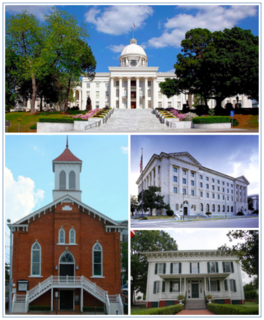The Greensboro massacre is the term for an event which took place on November 3, 1979, when members of the Communist Workers' Party and others demonstrated in a "Death to the Klan" march in Greensboro, North Carolina, United States. The CWP, which advocated that Klan members should be "physically beaten and chased out of town", exchanged gunfire with members of the Ku Klux Klan and the American Nazi Party. The CWP and supporters had handguns while KKK and Nazi Party members are visible on news footage from the event getting rifles from a car trunk and opening fire on CWP members. Four members of the Communist Workers' Party and one other individual were killed, and eleven other demonstrators and a Klansman were wounded. The CWP supported workers' rights activism among mostly black textile industrial workers in the area.
Victoria Snelgrove was an American journalism student at Emerson College. On October 21, 2004, approximately 90 minutes after the Boston Red Sox defeated the New York Yankees in the 2004 American League Championship Series, Boston police officer Rochefort Milien shot Snelgrove with an FN 303 blunt trauma / pepper spray projectile. This "crowd-control" bullet hit her eye, causing her to bleed excessively. Ambulances were blocked by the excessive crowds, which still refused to clear the area, preventing prompt medical attention from arriving from the dense medical area only a half-mile away.
False evidence, fabricated evidence, forged evidence or tainted evidence is information created or obtained illegally, to sway the verdict in a court case. Falsified evidence could be created by either side in a case, or by someone sympathetic to either side. Misleading by suppressing evidence can also be considered a form of false evidence, however, in some cases, suppressed evidence is excluded because it cannot be proved the accused was aware of the items found or of their location. The analysis of evidence may also be forged if the person doing the forensic work finds it easier to fabricate evidence and test results than to perform the actual work involved. Parallel construction is a form of false evidence in which the evidence is truthful but its origins are untruthfully described, at times in order to avoid evidence being excluded as inadmissible due to unlawful means of procurement such as an unlawful search.
Phillip Pannell was an African-American teenager shot and killed by police officer Gary Spath in Teaneck, New Jersey, on April 10, 1990. Pannell was fleeing police when he was shot; Spath was later charged and acquitted on charges of manslaughter. The case created controversy over the issues racial profiling and police brutality.
Kevin Lee Gaines was an American police officer assigned to the infamous Los Angeles Police Department Community Resources Against Street Hoodlums unit implicated in the Rampart scandal.

The Danziger Bridge shootings were police shootings that took place on September 4, 2005, at the Danziger Bridge in New Orleans, Louisiana. Six days after Hurricane Katrina struck New Orleans, members of the New Orleans Police Department who were allegedly responding to a call of an officer under fire shot and killed two civilians: 17-year-old James Brissette and 40-year-old Ronald Madison. Four other civilians were wounded. All of the victims were African-American. None were armed or had committed any crime. Madison, a mentally disabled man, was shot in the back.

Aiyana Mo'Nay Stanley-Jones, was a seven-year-old African-American girl from the east side of Detroit, Michigan who was shot and killed during a raid conducted by the Detroit Police Department's Special Response Team on May 16, 2010. Her death drew national media attention and led U.S. Representative John Conyers to ask U.S. Attorney General Eric Holder for a federal investigation into the incident.

Kenneth Chamberlain Sr. was fatally shot on November 19, 2011, in White Plains, New York. After his LifeAid medical alert necklace was inadvertently triggered, police came to his home and demanded that he open his front door. Despite his objections and statements that he did not need help, the police broke down Chamberlain's door, tasered him, and then fatally shot him. Chamberlain was a 68-year-old, black, retired Marine, and a 20-year veteran of the Westchester County Department of Corrections. He wore the medical alert pendant due to a chronic heart problem.

The Montgomery, Alabama Police Department was established in 1820. It employs about 524 sworn officers and another 200 support staff. It is headed by Chief of Police Ernest N. Finley.

On August 9, 2014, Michael Brown Jr., an 18-year-old African American man, was fatally shot by 28-year-old Ferguson police officer Darren Wilson in the city of Ferguson, Missouri, a suburb of St. Louis. Brown was accompanied by his friend Dorian Johnson who was 22. Wilson said that an altercation ensued when Brown attacked Wilson in his police vehicle for control of Wilson's gun until it was fired. Johnson stated that Wilson initiated a confrontation by grabbing Brown by the neck through his car window, threatening him and then shooting at him. At this point, both Wilson and Johnson state that Brown and Johnson fled, with Wilson pursuing Brown shortly thereafter. Wilson stated that Brown stopped and charged him after a short pursuit. Johnson contradicted this account, stating that Brown turned around with his hands raised after Wilson shot at his back. According to Johnson, Wilson then shot Brown multiple times until Brown fell to the ground. In the entire altercation, Wilson fired a total of twelve bullets, including twice during the struggle in the car; the last was probably the fatal shot. Brown was hit a total of six times from the front.
The shooting of Antonio Zambrano-Montes occurred on February 10, 2015, in Pasco, Washington, United States. Zambrano, a 35-year-old man originally from Michoacán, Mexico, was shot and killed by three police officers after allegedly throwing rocks at cars and police officers. His hands were not in the air when the police fired the shots. Police officers said one of the rocks was as large as a softball. A toxicology report conducted by police found Zambrano's blood tested positive for methamphetamine.
The murder of Laquan McDonald took place on October 20, 2014, in Chicago, Illinois, when the 17-year-old African American was fatally shot by Chicago Police Officer Jason Van Dyke. McDonald was reported to have been behaving erratically while walking down the street, and holding a folding knife with a three-inch (7.5 cm) blade. Initially, internal police reports described the incident similarly and ruled the shooting justified and Van Dyke was not charged in the shooting at that time.

The shooting of Charley Leundeu Keunang, a 43-year-old Cameroonian national, occurred in Los Angeles, California, on March 1, 2015. He was shot by three Los Angeles Police Department officers.

On July 5, 2016, Alton Sterling, a 37-year-old black man, was shot dead at close range by two white Baton Rouge Police Department officers in Baton Rouge, Louisiana. The officers were attempting to control Sterling's arms, and Sterling was shot by them after reportedly reaching for the gun in his pocket. Police were responding to a report that a man in a red shirt was selling CDs and that he had used a gun to threaten a man outside a convenience store. The shooting was recorded by multiple bystanders.
Johnny Robinson (1947–1963) was a young African-American teenager who, at age 16, was shot and killed by a police officer in the unrest following the 16th Street Church Bombing in Birmingham, Alabama. Robinson and several others were allegedly throwing rocks at a car draped with a Confederate flag. A Birmingham police officer, Jack Parker, who was riding in the back seat of a police car, shot and killed Robinson. Parker was never indicted for the killing and claimed that he had only fired a warning shot, and that a stray pellet must have killed Robinson.

In the late evening of March 18, 2018, Stephon Clark, a 22-year-old black American man, was shot and killed in Meadowview, Sacramento, California by Terrance Mercadal and Jared Robinet, two officers of the Sacramento Police Department. The officers were pursuing Clark because he had allegedly been breaking windows. When they confronted the unarmed Clark, he sprinted from the police in an encounter that was filmed by police video cameras. A Sacramento County Sheriff's Department helicopter was involved in observing an individual on the ground and in directing ground officers to the point at which the shooting took place. Helicopter video footage was released three days after the shooting. The officers stated that they shot Clark, firing 20 rounds, believing that he had pointed a gun at them. After the shooting, police reported that he was carrying only a cell phone. According to an independent autopsy, Clark was shot eight times, including six times in the back. However, the Sacramento County Coroner's autopsy report concluded that Clark was shot seven times, including three shots to the right side of the back.
On November 22, 2018, Emantic Fitzgerald Bradford Jr., an African-American man, was shot three times from behind and killed by police on the night of Thanksgiving, at the Riverchase Galleria shopping mall in Hoover, Alabama. Police responded to a shooting at the mall where two people were shot. Another African-American man suspected in the first shooting was arrested in Georgia a week later and charged in the shooting of one of those injured. The shooting of Bradford was immediately controversial, and was condemned by the Alabama NAACP as an example of racially biased policing.









